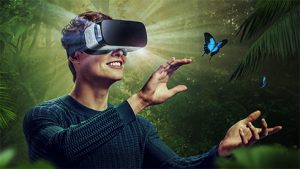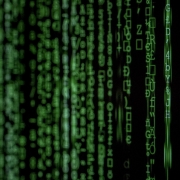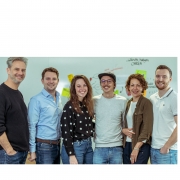- Looking behind, looking ahead. - 19. October 2016
The rules of VR are still unwritten. A rare opportunity for brand communication.
Innovations in the communication sector are routinely advertised and seldom redeemed. With virtual reality, it is different. This ‘Next Big Thing’ justifies every hype. VR used to be under rather than overestimated because it really is a completely new medium.
When a new, successful medium develops, it must be compared for a time with what is already known, in order to learn about the concepts. This influences the creative form for a while. Film began as, ‘living photography, perfect in every detail and life-sized’, television as visual radio, the World Wide Web as hypertext. With VR it is exactly as the name implies, which in this case refers to: VR is ‘something like reality’. Naturally, VR explains as little about reality as any other medium. But we leave out research and convention, in order to classify VR as a medium. That is why every article about VR is a personal account, and that is why experience really makes a difference here: you cannot grasp what you have not experienced.
VR will be regarded as an immersive medium, with the promise of ‘as if’ — as if you were there, as if you are the person, being represented. The idea of visual immersion is, however, actually older. In 1787 Robert Barker built his walk-in, 360-Degree-Views and called it ‘Panorama‘. Even older are the ‘peep-boxes’, which were popular in 19th-century salons and funfairs; small, wooden apparatuses for viewing exhibitions on paper, wood or glass. Early VR-Gears as well.
These panoramas and peep-boxes were primarily optical illusions. With digitalisation in the 1980’s, came tactility in production, the viewer becoming an actor. Jaron Lanier developed the ‘Data Glove‘ and characterised the notion of Virtual Reality. The visual representation, which the Data Glove can operate, is still abstract and prone to blocks, but trendsetting. One’s own body awareness influences what we see. We can act within the picture.
In modern VR both come together — physicality and panorama. To that end, VR has a few tricks up its sleeves, which effectively outwit our brain. And currently, it seems to be, as if we still fall for this repeatedly. The transfer to the virtual abyss in the laboratory for the umpteenth repetition got the heart pounding and generated measurable, bodily fear. False experiences in the VR-Dummy, the simulated person, who ‘I’ am, can trigger quasi-traumatic effects. So noticeable , that the consciousness researcher Thomas Metzinger, formulated an Ethics of VR Production with his colleagues.

In British Thorpe Park, the mentalist and illusionist Derren Brown, been sending visitors to his ‘Ghost Train‘ since July. Equipped with a VR gear kit, you are literally a participant in a gruesome scenario, attacked by demons and other such passengers. Brown strengthens the already convincing VR illusion with motion, change of location, and being touched by actors. Pure immersion.
And there is a lot to say about it, that this miracle of ‘presence’ passes, that it is a phenomenon of the pioneer phase. It does not lack the experience of recipients or the rules of form. Both producers and recipients are still experimenting. It is an exploration of the grammar of the medium, the conventions made possible.
This shows in a wide variety of forms, leading to an explosion of ideas. Currently, it seems VR can be anything: theatre, film, documentary, e-learning, horror-trip, and yes, even video conference. One of the founders of the US production firm Wevr, Anthony Batt, describes it perfectly [‘Studio 360’, New Yorker, 25. April 2016]:
‘Does that mean our stuff is always perfect? Fuck no! It means we start with no idea of how we´re gonna make a project work, and we make it work. Or we don´t, and the whole thing turns to jello, and we learn.’
It is a great opportunity for brand communication, to take part in the development of this grammar. Two features help in the process: first, today short formats are best suited for VR and second, are comparatively cost-effective, feasible productions.
Let’s face it: 90% of brand communication is more or less friendly circumvention. Re-targeting is no fun for the audience. With VR, an ad may finally be a spectacle. Well done, it allows your audience to have a (spectacular, enlightening, shocking) experience. To take part in this entirely new medium is an opportunity, that will not so quickly come again.

Join the VR experience live with our Roadshow “Reality by Virtuality” in Hamburg, Cologne, Munich and Berlin.
This page is available in DE





